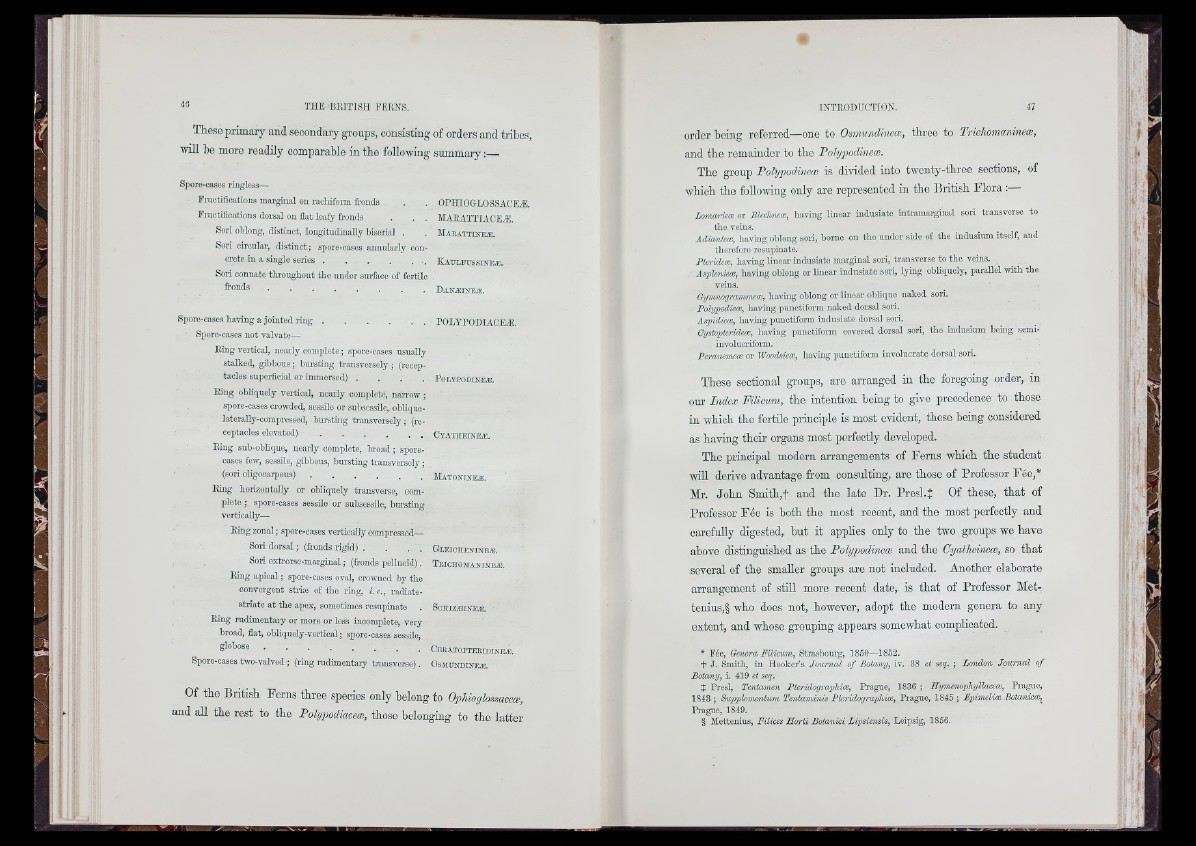
THE -BKITISII FERNS.
Those primary and secondary groups, consisting of orders and tribes,
will be more readily comparable in the following summary:—
Spore-casos ringless—
Fructifications marginal on rachiform fronds
Fructifications dorsal on flat leafy fronds . . .
Sori oblong, distinct, longitudinally biserial .
Sori circular, d is tin c t; spore-cases annularly concrete
in a single s e r i e s ...............................................
Sori connate throughout th e under surface of fertile
fronds ....................................................
Spore-cases having a jointed r i n g ................................................
Spore-cases n o t valvate—
Ring vertical, nearly complete; spore-cases usually
stalked, g ib b o u s; biu'sting transversely ; (recep
tacles superficial or immersed) .
Ring obliquely veiiácal, nearly complete, narrow
spore-cases crowded, sessile or subsessile, oblique
lateraUy-compressed, bursting transversely; (re
ceptacles elevated) . . . .
Ring sub-oblique, nearly complete, b ro a d ; spore
cases few, sessile, gibbous, bursting transversely
(sori o R g o c a r p o u s ) ..........................................
Ring lioiizontally or obliquely transverse, com
plete ; spore-cases sessile or subsessile, biu'sting
vertically—
Ring zona l; spore-cases vertically compressed—
Sori d o rs a l; (fronds rigid) . . . .
Sori exti-orse-marginal; (fronds p ellu c id ).
Ring a p ic a l; spore-cases oval, crowned by the
convergent strise of th e ring, i. e., radiate-
striate a t th e apex, sometimes resupinate
Ring rudimentary or more or less incomplete, very
broad, flat, obliquely-vortical; spore-cases sessile,
OPHIOGLOSSACEÆ.
MARAÏTIACEÆ.
M a r a t t in e æ .
K a u l f u s s in e æ .
D a n æ in e æ .
POLYPODIACEÆ.
POLYPODINISÆ.
C y a t i i e in e æ .
M a t o n in e æ .
G l e ic i i e n in e æ .
TmCIIOMANINEÆ.
S c i i iz æ in e æ .
Spore-cases two-valved ; (ring rudimentary transve ra e).
Ce b a t o p t e e id in e * .
OSMUNDIKEÆ.
Of the British Ferns three species only belong to Ophioglossaeece,
and all the rest to the Polypocliaeecu, those belonging to tho latter
order being referred—one to Osmunclineæ, threo to Tric/wmanineoe,
and tho remainder to tho Polypodinece.
The group Polypodinece is divided into twenty-three sections, of
which the following only are represented in the British Flora :
Lomariece or BlecJaiece, having linear indusiate intramarginal sori transverse to
th e veins.
Adianteæ, having oblong sori, home on th e under side of th e indusium itself, and
therefore resupinate.
Pterideoe, having linear indusiate marginal sori, transverse to th e veins.
Asp lmüoe , having oblong or hnea r indusiate sori, lying obliipuoly, parallel with tho
veins.
Chjmnogrammcoe, having oblong or linear oblique naked sori.
Polypodiece, having punotiform naked dorsal sori.
Aspidiece, having punctiform indusiate dorsal sori.
Oystopteridece, h a rin g punotiform covered dorsal sori, th e indusium being semi-
iuvolucriform.
Peranemce or Woodsiem, having punctiform involúcrate dorsal sori.
Those sectional groups, are arranged in the foregoing order, in
our Index Filicum, tho intention being to give precedence to those
in which the fertile principle is most evident, these being considered
as having their organs most perfectly developed.
The principal modern arrangements of Foms which the student
will derive advantage from consulting, are those of Professor Fée,*
Mr. John Smith,! and the late Dr. Presl.J Of these, that of
Professor Fée is both the most recent, and the most perfectly and
carefully digested, but it applies only to the two groups we have
above distinguished as the Polypodinece and the Cyatheineæ, so that
several of the smaller groups are not included. Another elaborate
arrangement of still more recent date, is that of Professor Met-
tenius,§ who does not, however, adopt the modern genera to any
extent, and whose grouping appears somewhat complicated.
* Fée, Oenora, Filieum, Strasbourg, 1850—1862.
t J. Smitb, in Hooker’s Journal o f Botany, iv. 38 et seq. ; London Journal o f
Botany, i. 419 et seq.
Î Presl, Tentamen Pieridographicc, Prague, 1836 ; Ilyrmnopliyllaceoe, Prague,
1843 ; Supplenientum Tentaminis Ptcridographioe, Prague, 1845 ; Epimelioe Botanicoe,^
Prague, 1849.
§ Mettenius, Filices Ilo r ti Botanici Lipsic^isis, Leipsig, 1856.
I
[;]
! !'■
I "